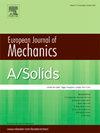Directional modeling concept for large strain metal plasticity
IF 4.2
2区 工程技术
Q1 MECHANICS
引用次数: 0
Abstract
This paper improves a modeling tool called “concept of representative directions”. Employing this approach, experienced and novice users can construct advanced nonlinear models of inelastic material behavior in a straightforward way. Unfortunately, the classical version of this concept lacks w-invariance, which effectively prevents the applicability to finite strain metal plasticity. To overcome this limitation, we introduce two enhanced versions of the concept that ensure w-invariance. The resulting material models are objective, with one approach also being thermodynamically consistent. These advancements are not purely theoretical: numerical tests demonstrate that the new formulations significantly improve the accuracy of modeling actual material behavior in the finite strain range. While the classical concept induces parasitic hardening, our advanced w-invariant models eliminate this inconsistency. Furthermore, the new approach has been implemented in the commercial FEM code MSC.MARC, and its practical utility is showcased through an initial boundary value problem. The generalizations to other material nonlinearities like metal creep and ratcheting are straightforward.
大应变金属塑性的定向建模概念
本文改进了一种称为“代表性方向概念”的建模工具。采用这种方法,有经验的和新手用户都可以直接地构建非弹性材料行为的高级非线性模型。不幸的是,这一概念的经典版本缺乏w-不变性,这有效地阻碍了对有限应变金属塑性的适用性。为了克服这个限制,我们引入了两个增强版本的概念,以确保w-不变性。所得的材料模型是客观的,其中一种方法也是热力学一致的。这些进步不仅仅是理论上的:数值试验表明,新的公式显著提高了在有限应变范围内模拟实际材料行为的准确性。虽然经典概念会导致寄生硬化,但我们先进的w不变模型消除了这种不一致。此外,该方法已在商业有限元代码MSC中实现。,并通过一个初边值问题说明了它的实用性。推广到其他材料的非线性,如金属蠕变和棘轮是直截了当的。
本文章由计算机程序翻译,如有差异,请以英文原文为准。
求助全文
约1分钟内获得全文
求助全文
来源期刊
CiteScore
7.00
自引率
7.30%
发文量
275
审稿时长
48 days
期刊介绍:
The European Journal of Mechanics endash; A/Solids continues to publish articles in English in all areas of Solid Mechanics from the physical and mathematical basis to materials engineering, technological applications and methods of modern computational mechanics, both pure and applied research.

 求助内容:
求助内容: 应助结果提醒方式:
应助结果提醒方式:


